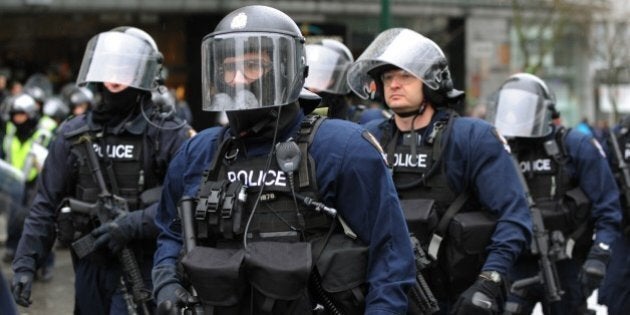
This week, we learned that the Toronto Police Service will be ordering C8 carbine semi-automatic assault rifles for front-line police officers.
The assault rifles, produced by arms manufacturer Colt Canada for the Canadian Forces, will cost $2,500 each, and will be in patrol cars on the streets of Canada's largest city by May. Toronto becomes only the latest municipality to acquire a weapon described on its website as "battle proven in harsh combat environments."
Late last year, Winnipeg police purchased a $400,000 armoured personnel carrier. A manufacturer video promoting the 14,000-pound, blast-proof Gurka MPV tactical vehicle with eight gun ports features heavy metal music and the words "make a statement" appearing on the screen.
Indeed, I have to wonder if that's what these purchases are all about -- making a bold statement about who makes the orders and who follows them.
Across Canada, local police forces are acquiring weapons and tools that are designed for military purposes, and policing is becoming increasingly militarized. The usual justification for ever more advanced weaponry is similar to Toronto Police Chief Mark Saunders' -- it makes officers safer in an era of declining violent crime.
Crime in Canada is down so much that even the right-wing Fraser Institute has called for scaling back police departments.
Some local police departments receive equipment donated by the Canadian Forces. That's how Windsor, Ontario and the mean streets of New Glasgow, Nova Scotia received armoured tanks free of charge.
Often, one event precipitates a build-up in arsenal and resources that the police keep long after the event is over.
Toronto Police purchased a Long Range Acoustic Device for the G20 Summit in 2010. Otherwise known as a sound cannon, this weapon was developed by the U.S. military to fight Somali pirates and Iraqi insurgents. It is powerful enough to make human bones vibrate, and it was used against Canadian citizens. It also continues to exist in the Toronto Police arsenal six years later.
"There is a difference between working with a community to build relations and foster trust, and patrolling a community that knows you are armed to the teeth with equipment that belongs in a combat zone."
The Vancouver Police Department continues to operate its secretive Military Liaison Unit, despite it being created to coordinate security for the 2010 Olympic Games with the Canadian Forces. The unit travels four to six times a year to a base in Washington State to train with U.S. Army and National Guard personnel, in effect receiving military training. Vancouver's MLU (there are others across the country) has seemingly no oversight or public accountability. In fact, even finding information on its existence is tough.
All of this is a major problem because a free and democratic society demands a clear separation between the military and your local police department in order to function and to safeguard the liberty we take for granted.
When we think about the militarization of the police, we often think of police in the U.S. These photos of local police officers responding to protests in Ferguson or Baltimore using some of the $450 million worth of war gear donated by the Pentagon to local departments is the kind of thing that comes to mind.
While Canada's Department of National Defence does not donate nearly as much or as advanced military hardware to local police forces as its American counterpart, millions of dollars have been spent by local departments across Canada on equipment originally developed with war zones in mind.
Not only has this led to massive expansions in local police budgets in an age of austerity, it erodes the fundamental function of police departments: to serve and protect the community.
The basic ideas upon which modern domestic policing in Canada and the U.S. are predicated find their provenance in 19th century British Prime Minister Sir Robert Peel and his Nine Principles of Law Enforcement.
They state: "the basic mission for which police exist is to prevent crime and disorder as an alternative to the repression of crime and disorder by military force and severity of legal punishment" and that "the degree of cooperation of the public that can be secured diminishes, proportionately, to the necessity for the use of physical force and compulsion in achieving police objectives."
There is a difference between working with a community to build relations and foster trust, and patrolling a community that knows you are armed to the teeth with equipment that belongs in a combat zone, not on their street. I argue that arming local police officers with the tools of a soldier is intimidation and amounts to compulsion.
The military and the local police department serve completely different roles. In an expensive race towards increasingly invasive and threatening policing methods, it has never been more important to remember that fundamental ideal.
Follow HuffPost Canada Blogs on Facebook
MORE ON HUFFPOST:
